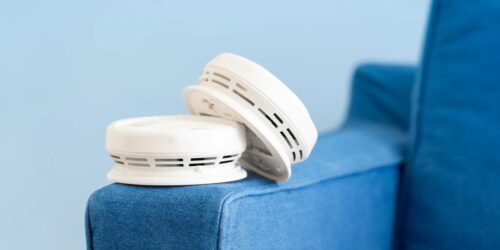
2.18.25 – Wire Cutter- By Liam McCabe
Bedding and furniture are rarely the first items to ignite in a house fire. But once they’ve been lit, the synthetic materials in modern furnishings burn faster and release more smoke and toxic gasses than natural materials, which were more common in the past.
UL, a nonprofit organization that sets the safety standards for smoke alarms and other products, published a startling video showing two rooms burning side by side: one with largely natural materials and the other furnished with synthetics.
Within five minutes, the room furnished with synthetic materials—such as engineered wood and several types of plastic, including polyurethane foam stuffing—was engulfed in flames. The one filled with natural materials—like cotton, solid wood, and glass—took more than 30 minutes to reach the same point. UL ran this experiment four times, with similar results in each.
As we reported in our guide to smoke alarms, the typical time to escape from a house fire has fallen from 17 minutes in the 1970s to about three minutes today. Every minute matters, and the latest smoke alarms are tested to buy you extra time.
After more than a decade of research and planning by several government, nonprofit, and industry groups, these safety staples have finally caught up with the fire risks posed by modern furniture.
The most important update to the smoke alarm safety standards (known as the UL 217, 8th edition), which went into effect in 2024, means that new alarms are better at detecting both smoldering and flaming fires in polyurethane foam—the material used to stuff modern furniture and bedding.
Upholstered furniture and mattresses are a significant factor in nearly half of house fires, and they’re associated with more than a third of all deaths, according to statistics published by the National Fire Protection Association (NFPA). But polyurethane foam fires were a challenge for older household smoke alarms to detect, according to Shawn Mahoney, an engineer at NFPA. Burning foam creates a different kind of smoke than the previous generation of alarms had been designed to look for. The particles are both very large and very small relative to the makeup of other common types of fire.
Crucially, new alarms are more sensitive to furniture foam fires—without also becoming more sensitive to smoke from normal cooking. Testing by the federal National Institute of Standards and Technology confirmed that although a pan full of sizzling bacon might still set off a nuisance alarm, it happens at about the same rate as the older generation of smoke alarms.

When smoke alarms trigger too easily, it’s a problem. As senior staff writer Doug Mahoney (no relation) said on a recent episode of The Wirecutter Show podcast, “If [nuisance alarms] happen enough, people get very frustrated with them, and then they just take the smoke alarm off their wall, take the batteries off it, and then leave themselves with no early warning system at all.”
Estimates vary on how often people purposely disable their smoke alarms because of those nuisances. But the NFPA has pointed to it as a notable cause of deaths from house fires. One study found that 19% of homes with ionization-type smoke alarms—known for greater sensitivity to cooking fumes—had them purposely disabled, likely as a result of cooking-related nuisance alarms. So it’s not a rare occurrence.
Get today’s recommendation
Expert advice. Very good deals. The absolute best (and worst) things we’ve tested lately. Sent to your inbox daily.Sign Up
For information about our privacy practices, including how to opt out of marketing emails, see our Privacy Policy. For general questions, contact us anytime.
Should you replace your old alarms?
The NFPA told us that they don’t have data on how many injuries and deaths might be prevented by the improvements to the newest alarms. But NFPA’s Mahoney stressed that any alarm is better than no alarm. “Working smoke alarms in the home reduce the risk of dying in a fire by more than half,” he said.
Even if you’re comfortable with smoke alarms that came out before the new rule went into effect, it’s wise to take an inventory of your current equipment and make sure it’s functioning properly. Here’s what to look for:
- Do they even work? Hit the test button and see if the alarm still sounds to make sure it’s not broken or disconnected.
- How old are they? The US Fire Administration says you should replace your smoke alarms every 10 years, as does the NFPA. The manufacturing date should be printed on the alarm, and whoever installed it may have written the precise installation date on the alarm, too.
- Do you have the right type? It’s easy to accidentally buy smoke alarms that don’t meet local codes, especially if you’re shopping online. I found out the hard way during a fire inspection before I sold my old condo that the popular ionization-type alarm I bought off Amazon didn’t meet my local fire code. First Alert has a state-by-state code lookup tool.
- Do you have one everywhere you’re supposed to? Fire codes vary, but safety groups like the NFPA recommend a smoke alarm inside every bedroom as well as outside of sleeping areas (like common hallways that connect bedrooms), and at least one on every level of the home, including basements and attics. The NFPA guidelines for reducing nuisance alarms say that a typical ionization-type smoke alarm should be at least 20 feet away from your stove, because cooking is more likely to trigger those nuisance alarms.
- Are they interconnected? When one unit senses smoke, all of the alarms in the system will sound—a setup that has been found to increase effectiveness, according to the US Consumer Product Safety Commission. They’ve been required for decades by most building codes, though old buildings are often excluded from those requirements. Recently, it’s become much easier to wirelessly interconnect a household’s worth of smoke alarms.
- Are they certified for safety? Though smoke alarms that don’t meet UL safety certifications aren’t supposed to be sold in the US, online marketplaces (including Amazon) sometimes have listings for them. If the badge isn’t printed on your alarm, it doesn’t qualify. Off-brand smoke alarms with fraudulent UL safety badges have also been found online, so consider checking the UL or Intertek listing databases to see if yours actually passed the safety tests.
What if your alarms still work, but they’re aging, or missing some of the now-standard safety features like interconnection?
“I think everyone has to do their own risk assessment,” says Doug. “As a personal note, as soon as I wrapped my head around what the new standards offer and looked at the data and evidence, I immediately upgraded all of the smoke alarms in my house with the new models.”
This article was edited by Megan Beauchamp and Maxine Builder.
Further reading
- If You Get Only One Smart Home Device, Please Make It This OneMore than any other smart device, a smart smoke detector is so much better than a regular one, and it’s so important, we think they belong in every home.
- The Best Basic Smoke AlarmA working set of interconnected alarms maximizes your likelihood of safely evacuating during a home fire.
- The Fire Extinguisher, Smoke Detector, Carbon Monoxide Detector, and Other Safety Essentials You Need in Your HomeHere’s what you need at home to prepare for seriously bad (but entirely plausible) scenarios.
Meet your guide

Liam McCabe
My beat is home improvement in a broad sense: I cover tools and maintenance and upgrades (DIY or otherwise), as well as air quality and energy efficiency, plus big-ticket purchases such as major appliances and HVAC.
